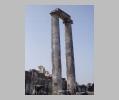
Side entrance to Hypaethral court, Temple of Apollo. Didyma, Temple of Apo...

Hypaethral Court in the Temple of Apollo from the Northwest, Didyma.

Column base. Didyma, Temple of Apollo.

Hypaethral Court in the Temple of Apollo, Didyma.
| Summary: | The major Anatolian sanctuary dedicated to Apollo. |
| Type: | Sanctuary |
| Region: | Ionia |
Periods:
Dark Age
Geometric
Archaic
Classical
Hellenistic
Roman
Physical:
Located ca. 10 km S of the city of Miletus and inland from the small port of Panormos, the site of Didyma (a pre-Hellenic name) was a cult center with a spring and sacred grove before the arrival of the Ionian Greeks. In the Archaic period the first temple of Apollo was constructed and a Sacred Way, lined with sculptures, led from Panormos to the sanctuary. Additional structures at the sanctuary included a temenos wall, stoas, and a circular altar and a sacred well before the temple.
The open-cella Archaic temple was replaced by a larger unroofed temple in the Hellenistic period. The Hellenistic temple of Apollo, although never completed, survives as one of the largest and most impressive examples of ancient Greek architecture. The temple housed a small Naiskos within the open cella and had an unusual room between the pronaos and cella which may have served as the Chresmographeion (office of the oracle). Also present at the sanctuary were other shrines, a stadium, and a settlement of priests and attendants. Although musical and drama contests were held as part of the Festival of the Great Didymeia every four years, there is no theater nor odeion at the sanctuary.
Description:
Didyma was originally a pre-Greek cult center with a spring and sacred grove. The Ionian Greeks adopted and Hellenized the center and by the 7th century B.C. the fame of its oracle had spread to as far as Egypt. The earliest temple of Apollo on the site was an unroofed Ionic building enclosing the sacred spring and a Naiskos. It was completed in the first half of the 6th century B.C. A second and larger temple on the same spot was destroyed by the Persians early in the 5th century B.C. while it was still under construction.
Little is known about activities at Didyma during the 5th and 4th centuries B.C., it it seems to have suffered a decline. The sanctuary and the office of the oracle was revived at ca. 311 B.C. when the sacred spring reappeared (or was rediscovered) on the occassion of a visit from Alexander the Great. In the following decades Selencus embellished the sanctuary and commissioned the new Hellenistic Temple of Apollo. The sanctuary grew in wealth and fame and work on the temple continued for the next 200 years.
In 278 B.C. the sanctuary suffered under the raids of Gauls, but construction work on the temple was resumed. At 70 B.C. the sanctuary was sacked by pirates and work on the temple stopped. The sanctuary continued to function and in A.D. 100. Trajan commissioned a new paved road to the sanctuary from Miletus.
By the 3rd century A.D. Christianity had become well established in the Miletus area and the sanctuary at Didyma fell into disuse. At ca. A.D. 262 the Temple of Apollo (which had never been completed, despite five centuries of service), was converted into a fortress against the invading Goths.
Exploration:
Sources Used:
Other Bibliography:

